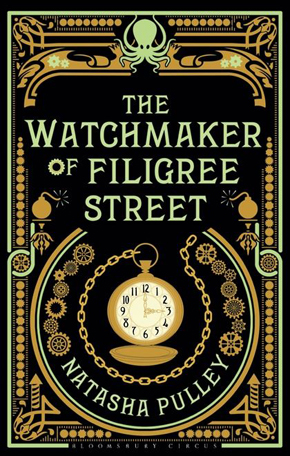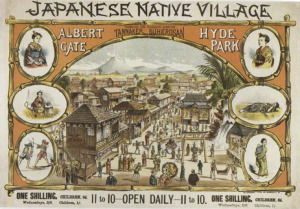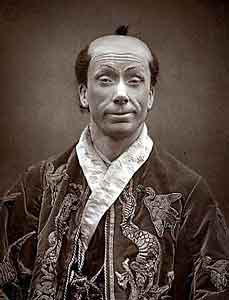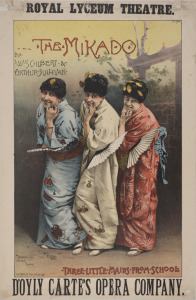The empress’s new clothes
by Natasha Pulley
“Pulley’s electrifying debut is a triumph of speculative fiction.” Publishers Weekly
One of the things that crops up a lot if you set fantasy in a historical period is, what’s real? I wrote about a watchmaker who remembers the future and that was fun, but it made everything else in the book look like I might have made it all up. Actually, I didn’t really make any of it up. The fantasy stops at the top of the street he lives on. I didn’t make up the experiments in weather control carried out by physicists in the 1880s, nor the theory of the luminiferous ether, which for decades confirmed the claims of spiritualists and suggested the possibility of consciousness after death. But most importantly — the watchmaker is Japanese — I didn’t make up the influence Meiji Japan and Victorian London had on each other.
In 1885, inside Humphreys’ Hall on the edge of Hyde Park, a new part of the Great Exhibition opened. It was a replica Japanese village. It came complete with a teashop, a shrine, and a full complement of artisans who had come specially from Japan. Over a hundred people lived there. They wore traditional dress and made very Japanese things, everything from lacquerwork to parasols. It cost a shilling to go in and over three years, a million people visited. The whole exhibit was so successful that, even though it caught fire after only a year or so, it was immediately rebuilt bigger and better, with a new pagoda and bridge.
Probably its most famous influence was on The Mikado. Gilbert and Sullivan went to the village for research; they even recruited a Japanese girl to help train their actors to dance. She was an excellent teacher, though everyone had trouble talking to her, because nobody in the cast knew any Japanese except ‘sayonara’ and all she knew how to say in English was (she served tea at the show village) ‘sixpence each’. Of course, they didn’t much go in for cultural accuracy. The Mikado is a name for the Japanese Emperor, but that’s about as much real Japanese as there is in the operetta. It wasn’t for lack of ability. According to Gilbert, ‘the chief secret of practical success is to keep well within the understanding of the least intelligent section of the audience’, and so to his view there could hardly have been any point bothering with over-authenticity. Unsurprisingly, what was really going on in Japan at the time didn’t bear much resemblance to the amblings of Nanky-Pu and Yum Yum, or even to the neat charm of the Knightsbridge village.
 The Meiji period, which matches the second half of the Victorian period in England, is named after Emperor Meiji. Meiji was a new sort of leader. Before him, Japanese emperors were constitutional monarchs while the real political power lay with the shogun, but a civil war changed all that. It was the Tokugawa shoguns who had closed Japan to the world; for two hundred years it had been illegal for westerners to set foot on the mainland. In 1862, a British man called Richardson was literally cut to pieces for being disrespectful to a samurai lord. But Meiji was a moderniser. The new government came up with a series of slogans to inspire people with and one of the most famous is ‘catch up, overtake’. They were talking about the west. The whole notion was taken very seriously indeed. Within a few decades, Japan had a constitution like America’s, a fleet of ironclads made in Liverpool, and an army modelled on the best in the world at the time, the Prussian.
The Meiji period, which matches the second half of the Victorian period in England, is named after Emperor Meiji. Meiji was a new sort of leader. Before him, Japanese emperors were constitutional monarchs while the real political power lay with the shogun, but a civil war changed all that. It was the Tokugawa shoguns who had closed Japan to the world; for two hundred years it had been illegal for westerners to set foot on the mainland. In 1862, a British man called Richardson was literally cut to pieces for being disrespectful to a samurai lord. But Meiji was a moderniser. The new government came up with a series of slogans to inspire people with and one of the most famous is ‘catch up, overtake’. They were talking about the west. The whole notion was taken very seriously indeed. Within a few decades, Japan had a constitution like America’s, a fleet of ironclads made in Liverpool, and an army modelled on the best in the world at the time, the Prussian.
Ito Hirobumi, who was later to become Prime Minister, pointed out very early on that nobody was going to take Japan seriously while everyone was dressed, to Western eyes at least, like novelty dolls.”
Meanwhile, money poured into foreign relations. A huge new foreigners’ residence was built in Hibiya Park in Tokyo. This was the Rokumeikan, or Deer Cry Hall, so called after a Chinese poem about hospitality. It was the site of fabulous balls and parties. Everyone who attended was required to learn Western-style dances and encouraged to wear Western clothes. Although this mimicry was met with some puzzlement by visiting Western diplomats – sometimes even distaste – the reason behind it all is very clear. Ito Hirobumi, who was later to become Prime Minister, pointed out very early on that nobody was going to take Japan seriously while everyone was dressed, to Western eyes at least, like novelty dolls. It was a colossal effort at translation.

 Although Arinori Mori was quite extreme, and there were other ministers just as extreme in the opposite direction, the usual tactic of the new royal family was compromise. When the new constitution was announced in 1889, the Empress wore a new dress. It was in the traditional style, and it cost more than the new Foreign Ministry. On the other hand, it was almost unheard of, in strict tradition, to see the wife of the Emperor at all — that was a Western import, and so therefore was the public appearance of the fabulous dress. The empress’s dress is quite a good symbol of Meiji culture generally. It magpied all the interesting or useful bits about other cultures, drenched it in funds, gave it a Japanese spin and marched on. The scale of importation was incredible, but it had been done before, a thousand years previously, when an immense amount of Chinese culture, from writing to fashion, was absorbed into life on the Japanese mainland. It was something Meiji politicians didn’t hesitate to point out to those conservatives worrying about eroding what was quintessentially Japanese about Japan. The quintessential Japaneseness was this marvellous capacity to borrow.
Although Arinori Mori was quite extreme, and there were other ministers just as extreme in the opposite direction, the usual tactic of the new royal family was compromise. When the new constitution was announced in 1889, the Empress wore a new dress. It was in the traditional style, and it cost more than the new Foreign Ministry. On the other hand, it was almost unheard of, in strict tradition, to see the wife of the Emperor at all — that was a Western import, and so therefore was the public appearance of the fabulous dress. The empress’s dress is quite a good symbol of Meiji culture generally. It magpied all the interesting or useful bits about other cultures, drenched it in funds, gave it a Japanese spin and marched on. The scale of importation was incredible, but it had been done before, a thousand years previously, when an immense amount of Chinese culture, from writing to fashion, was absorbed into life on the Japanese mainland. It was something Meiji politicians didn’t hesitate to point out to those conservatives worrying about eroding what was quintessentially Japanese about Japan. The quintessential Japaneseness was this marvellous capacity to borrow.
Japan often appears in steampunk fantasy. Part of that is to do with steampunk’s roots in Victoriana, and that Japan was making itself known on the international stage at just that point in time. In part, though, I think it’s to do with how fantastical Meiji history can be too. The idea of a country where the older generation fought in armour on horseback but the younger could be found on London underground trains sounds like the maddest sort of fiction. But it’s all true.
 Natasha Pulley studied English at Oxford and worked as a bookseller at Waterstones, then as a publishing assistant at Cambridge University Press, before completing a Creative Writing MA at UEA. She has recently returned from Tokyo, where she lived for nineteen months on a scholarship from the Daiwa Anglo-Japanese Foundation. The Watchmaker of Filigree Street, her first novel, is published by Bloomsbury Circus in hardback and eBook.
Natasha Pulley studied English at Oxford and worked as a bookseller at Waterstones, then as a publishing assistant at Cambridge University Press, before completing a Creative Writing MA at UEA. She has recently returned from Tokyo, where she lived for nineteen months on a scholarship from the Daiwa Anglo-Japanese Foundation. The Watchmaker of Filigree Street, her first novel, is published by Bloomsbury Circus in hardback and eBook.
Read more.

